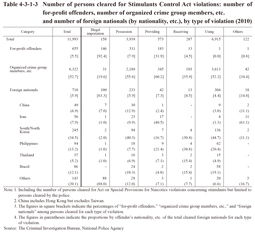Chapter 3 Drug Offenders
Section 1 Trends in Offenses
1 Stimulants Control Act violations
Fig. 4-3-1-1 shows the number of persons cleared for Stimulants Control Act (Act No. 252 of 1951) violations (including Act on Special Provisions for Narcotics violations concerning stimulants; hereinafter the same in this section) from 1951. Stimulant abuse first commenced during the chaotic postwar period, with the number of persons cleared reaching the primary peak of more than 50 thousand in 1954, however, stricter penal provisions, clearance, and thorough implementation of educational campaigns on the harmful influence of stimulants, etc. resulted in a subsequent sharp decrease. The number of persons cleared then started to increase from 1970, however, reaching the secondary peak of 24,372 in 1984. It then turned to a decreasing trend again, falling below 20,000 in 1989, but then started increasing again from 1995 and reached nearly 20,000 in 1997. In recent years the number was generally on a decreasing trend from 2001.
Fig. 4-3-1-1 Number of persons cleared for Stimulants Control Act violations (1951-2010)
Fig. 4-3-1-2 shows the number of persons cleared (limited to those cleared by the police) for Stimulants Control Act violations by age group over the last 30 years. The number of cleared persons aged 20-29 was the highest of all age groups between 1985 and 2001, but was on a significant decreasing trend since then. From 2002 the number of those aged 30-39 was the largest. The number of cleared persons younger than 20 was on a decreasing trend since 1998, and in 2010 decreased by 11.3% from the previous year.
Fig. 4-3-1-2 Number of persons cleared for Stimulants Control Act violations by age group (1981-2010)
Table 4-3-1-3 shows the number of persons cleared for Stimulants Control Act violations (limited to those cleared by the police) in 2010, and the number of them cleared for offenses with the purpose of profit (for-profit offenders), organized crime group members, etc. (refers to regular members and quasi-members of organized crime groups; hereinafter the same in this subsection) and foreign national offenders (by their nationality, etc.) by type of violation. The percentage of those cleared for Stimulants Control Act violations with the purpose of profit was 5.5% in 2010. The percentage of organized crime group members, etc. was rising from 2003, reaching over 50% from 2005, and was 52.7% in 2010 (See the Appendix). The percentage of foreign national offenders was 5.9% in 2010. By nationality, etc., the largest number came from South/North Korea (34.5%), followed by the Philippines (13.2%), Brazil (12.1%), and Iran (7.9%).
Table 4-3-1-3 Number of persons cleared for Stimulants Control Act violations: number of for-profit offenders, number of organized crime group members, etc. and number of foreign nationals (by nationality, etc.), by type of violation (2010)
The countries or places from which the stimulants seized in 132 cases of illegal importation of stimulants cleared by the police in 2010 were shipped included China (excluding Taiwan, Hong Kong, and Macao) accounting for the largest number at 23 cases, followed by Taiwan at 15, the United Arab Emirates at 11, Nigeria at 10, Hong Kong at 9, and Malaysia at 9 (Source: The Criminal Investigation Bureau, National Police Agency).


